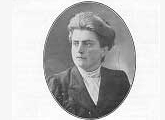Somerville and Ross
Born into land-owning Protestant families in the South West of Ireland in the mid-nineteenth century, Edith Œnone Somerville (1858-1949) and Violet Martin (1862-1915), wrote in partnership as Somerville and Ross. Their novels and short stories intimately detail the social and political conditions of the late nineteenth and early twentieth century in Ireland. They produced one of the most popular and best-selling series of comic Irish short stories of its time - the Irish R.M. tales (1899-1914) - as well as one of Ireland's most critically acclaimed novels to date, The Real Charlotte (1894). After Ross's death, Somerville received messages from her via 'automatic writing', and used this spiritual communication to continue their literary collaboration.
The Somerville and Ross archive at Queen's University Belfast mostly consists of the duo's literary papers, personal correspondence, diaries, and Somerville's pen-and-wash book illustrations and pencil sketches. The current exhibition at Queen's pays testament to the neglected literary and other personal and professional achievements to which Somerville and Ross can lay claim. To coincide with this exhibition, the Archives Hub is highlighting the descriptions of the Somerville and Ross archive and related collections, and links to other resources on the Web.
The complete extant correspondence (GB 752 SRMC MS 17/878) between Edith Somerville and Ethel Smyth (1858-1944), which forms part of the Somerville-Ross collection at Queen's, has been digitised. When all transcriptions are complete the letters will be fully searchable.
 Left, detail of letter from Edith Somerville to Ethel
Smyth. Photograph copyright Somerville and Ross Literary Estate
c/o Curtis Brown Ltd. This is a link to a larger image.
Left, detail of letter from Edith Somerville to Ethel
Smyth. Photograph copyright Somerville and Ross Literary Estate
c/o Curtis Brown Ltd. This is a link to a larger image.
Somerville and Smyth were both notable female figures in Irish literary and English and European musical circles respectively. Somerville was both painter and author, most particularly in collaboration with her cousin Violet Martin. Smyth was a celebrated composer and the most prominent female figure in early twentieth-century English musical life. Prompted by her friend Virginia Woolf (1882-1941), she also wrote several autobiographies. Both Somerville and Smyth were active supporters of the women's suffrage movement during the 1890s. The letters are of foremost value in retracing the political/cultural interventions of Irish and English artistic women in the early twentieth century and contributing to new interpretations of women’s socio-political activity in the period. The correspondence between Somerville and Smyth details the personal and working relationship of the two women, the difficulties of pursuing their literary/musical ambitions in a patriarchal environment, and the history of strife in the 1920s in south Cork.
Collections
- Somerville and Ross: a significant collection of personal and literary papers.
- Ethel Mary Smyth (1858-1944): composer, writer, and campaigner for women's suffrage; close friend of Edith Somerville.
- Nevill Coghill (1899-1980): nephew of Edith Somerville; literary scholar, and theatrical producer and director; broadcast a talk on BBC radio on the occasion of Edith Somerville's 90th birthday.
- Maria Edgeworth (1768-1849): novelist much admired by Somerville and Ross; Violet Martin inherited her great-grandmother's correspondence with Edgeworth.
Collections' annotations: acknowledgements to Maurice Collis Somerville and Ross : a biography (London: Faber, 1968) and Gifford Lewis Somerville and Ross : the world of the Irish R.M. (Harmondsworth : Viking, 1985)
Links
- National Portrait Gallery, London: Violet Martin by Edith Somerville, 1886; Dame Ethel Mary Smyth, sixteen portraits; Nevill Coghill, photograph, 1944.
- Two Somerville and Ross works are available online as free 'e-books' All on the Irish shore: Irish sketches, 1900, and Mount Music, 1919 (Project Gutenberg website)





